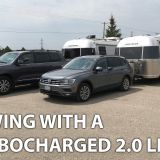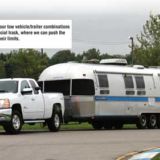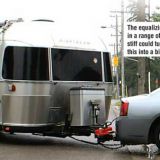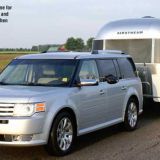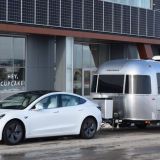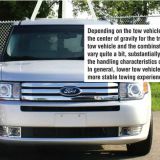Hitching the Family Sedan
We often use family sedans to pick up and deliver trailers.
While it is neat to write about towing travel trailers with cool cars like Jaguars and Taurus SHO’s, a great deal of our towing for the RV dealership is done with less expensive older cars.
We pile a lot of kilometers on vehicles doing deliveries and picking units up at the factories, so running new high-end vehicles all the time gets rather costly, especially when you consider how great a deal you can get on a good used car. Besides the newer tow vehicles on our lot, we have a 1997 Cadillac Deville, a 2007 Dodge Charger, and last year we acquired this 2006 Chevrolet Impala as a trade-in.
During our vacation trip last year, we needed an extra travel trailer to accommodate the family, so my daughter towed a 19’ Airstream with the ’06 Impala. I got to drive the SHO, so there are some benefits to getting old.
In some ways, the Impala is like an old friend. The first modern front-wheel drive sedans we towed with were full size GM products, starting with our ’87 Olds 88. Over the years, we have put hitches on a few hundred of these cars, and for many years, I drove derivatives of this platform.
What first attracted us to these cars 25 years ago was the handling. This was the first mainstream vehicle with four-wheel independent suspension, rack and pinion steering and a very good tire and wheel combination. When we first got the Impala, it was not a “handling machine” – the suspension was definitely geared to be soft and mushy. Mind you, the car was 5 years old, but it only had 72,000 kilometers on it. We decided to modify the Impala for trailer towing.
 The first step was to add some new Munro Sens-a-Track Struts. These made a huge difference to the ride control and handling. This spring, it was time to replace the 225/60R x 16” tires so we decided to ditch the steel wheels and switch to 235/50 x 17” tires which further improved the handling yet the ride is still pretty smooth. In the end, this gave us the suspension tuning we always look for – relatively soft springs with lots of shock control and precise tires.
The first step was to add some new Munro Sens-a-Track Struts. These made a huge difference to the ride control and handling. This spring, it was time to replace the 225/60R x 16” tires so we decided to ditch the steel wheels and switch to 235/50 x 17” tires which further improved the handling yet the ride is still pretty smooth. In the end, this gave us the suspension tuning we always look for – relatively soft springs with lots of shock control and precise tires.
Most of our towing experience with GM sedans was with vehicles that had the almost invincible 3.8 litre V6; the Impala has a slightly smaller 3.5 litre V6 mated to what is now a quaint 4-speed automatic. Though it is only 4 gears, it has certainly proven reliable for long term towing.
The 3.5 litre is somewhat dated technologically, even for 2006, with only two valves per cylinder, so it only produces 211 HP and 214 ft. lbs of torque. Compare this to the Taurus SHO which produces 365 HP and 350 ft. lbs. of torque from the same 3.5 litre displacement. On the other hand, you can buy six good used low mileage Impalas for the price of a single new Taurus SHO.
"Towing in the hills of West Virginia, the Impala was able to climb easily and it could actually run away from the diesel pusher motorhome in our group."
Fuel economy on last summer’s trip with the Impala and 19’ Airstream was quite good, varying between 13.8 and 17.5 mpg, or 16 – 19 L/100 km., solo economy on the highway at 110 kph is very good – it runs along at 7.5 L/100 km’s or 37 mpg. Towing in the hills of West Virginia, the Impala was able to climb easily and it could actually run away from the diesel pusher motorhome in our group. The only time it was challenged was trying to stay with 70 mph traffic in a 20 mph headwind. The bottom line is that this drivetrain has no real problem with weight, but it is limited by its capacity to overcome air drag which makes a combination with a streamlined trailer like the Element an ideal match.
So the question is why would you buy a $7,500 car to tow a $45,000 trailer? At first glance, it does not seem to make sense – but if you think about it, there is a very logical case to be made for this decision.
The used Impala cost $7,500. We added the tires, shocks, hitch receiver, brake control and wiring and a transmission cooler. By the time we were done, the total cost of the tow vehicle was $10,500.00. If you drive 25,000 kilometers a year, you can drive this car for five more years without a problem and let’s assume its market value will be negligible at that time. We find aerodynamic, well-made trailers have very good resale value, so in five years the Element could still be worth $30,000 or more, but it would easily be reliable for another 20 years if you want to keep it that long.
One the other hand, you could buy a new conventional trailer for $22,000 and a new half-ton pickup to tow it with. The truck is going to cost about $33,000 and it will be worth around $12,000 in five years. At that time, the trailer will be worth about $10,000. So in both cases, you lay out about $55,000 and in five years the Element will likely be worth more than the truck and the conventional trailer combined.
If you decide to replace the truck in five years, you still need another truck to continue to tow the less than aerodynamic basic trailer, but you can choose from plenty of fuel efficient inexpensive vehicles to tow the Element. During the five years, you will likely spend some money on the Impala for repairs that you won’t have to spend on the truck, but you will spend a great deal less on fuel. In the meantime, you will get much better handling with greater safety and likely a better day-to-day vehicle. Bottom line – a high quality, easy to tow trailer is a better investment than a fancy new tow vehicle. On the other hand, if you really love driving a shiny new pickup you may never be happy with this plucky little 4-door sedan.
As my accountant once said, “I am not here to tell you what to do, but I hope I have made you think.”
Interested in towing with a family-style sedan? Call Can-Am RV today to arrange a test drive.
Originally published in RV Lifestyle, Volume 41, No. 3.


